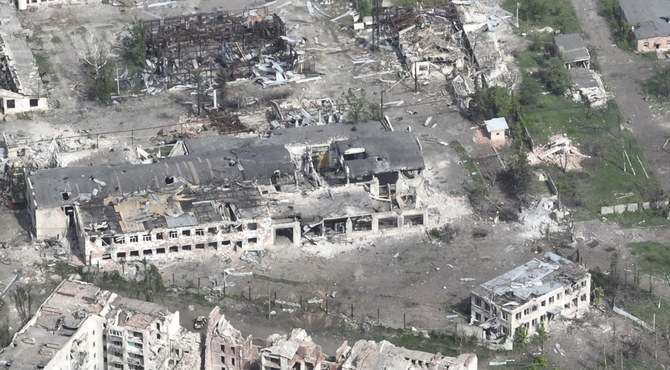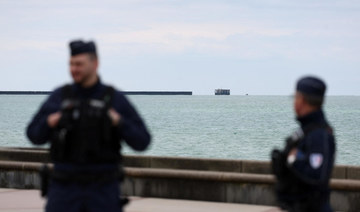WASHINGTON: The administration officials who gave President Donald Trump’s tax plan a splashy debut in recent days seem to have caught the exaggeration bug from their boss.
A look at some statements by Trump and his aides over this past week, and the facts behind them:
TREASURY SECRETARY STEVE MNUCHIN, on Trump having “no intention” of releasing his own tax returns ever: “The president has released plenty of information and I think has given more financial disclosure than anybody else. I think the American population has plenty of information.”
THE FACTS: Trump has released less than other presidents in modern times.
By withholding his tax returns, Trump has fallen short of the standard followed by presidents since Richard Nixon started the practice in 1969.
During last year’s election campaign, Trump argued that he couldn’t release his taxes because he was under an audit by the IRS. That reason didn’t hold up, because being under audit is no legal bar to a candidate from releasing tax returns. On Wednesday, Mnuchin seemed to abandon even that explanation.
What Trump has released are financial disclosure forms that list his assets and liabilities in broad ranges, required by law. But those forms don’t disclose precise numbers, and they include nothing about a person’s income or charitable giving — data disclosed only in tax returns.
The few Trump tax returns the public has seen weren’t released by him, but disclosed by news outlets. Two leaked pages of his 2005 return that came out in March didn’t include full details on income and deductions, but did show that he would have benefited massively by an elimination of the alternative minimum tax — a feature of his just-outlined tax plan. And three pages that surfaced last year showed he had claimed a $916 million loss on his 1995 return, which could be used to reduce his taxes by offsetting later gains.
MNUCHIN: “This is going to be the biggest tax cut and the largest tax reform in the history of our country.”
THE FACTS: Apparently not. At first blush, the tax cuts look smaller than President Ronald Reagan’s in 1981, which were the biggest ever. That plan reduced federal revenues by almost 19 percent, according to a Treasury report. In today’s dollars, that would mean a tax cut of more than $600 billion a year or well over $6 trillion over the next decade.
An early analysis by the nonpartisan Committee for a Responsible Federal Budget estimates federal revenue would probably drop $5.5 trillion over a decade under the Trump plan, shy of Reagan’s record-breaker. That assumes all elements of the plan are approved by Congress, which is unlikely.
The biggest-ever claim is also made on the one-page outline of the plan. Trump economic adviser Gary Cohn, more realistically, called it “one of the biggest.”
MNUCHIN: The tax plan “will pay for itself with growth,” reduced deductions and “closing loopholes.”
THE FACTS: Tax experts are skeptical, and they’re backed up by history.
Reagan’s steep cut in 1981 contributed to years of deficits, even after he was forced to raise some taxes in subsequent years to stem the red ink. President George W. Bush’s 2001 and 2003 tax cuts were also followed by large deficits.
“No tax cut has ever been self-financing,” said Howard Gleckman, a senior fellow at the nonpartisan Tax Policy Center.
In its analysis of the Trump plan, the Committee for a Responsible Federal Budget said “no achievable amount of economic growth could finance it” and it would drive the debt to 111 percent of the gross domestic product by 2027, compared with 77 percent now. The group advocates for deficit reduction as a pillar of economic growth.
Alan Cole, an economist at the right-leaning Tax Foundation, has calculated that Trump’s corporate tax cut alone would cut federal revenue by $2 trillion over 10 years. Growth would need to accelerate to 2.8 percent a year, from its current pace of about 2 percent, to pay just for that cut. But Cole forecasts growth would increase by only half that amount, resulting in ballooning deficits.
COHN: “We are going to cut taxes for businesses to make them competitive and we’re going to cut taxes for the American people, especially low- and middle-income families.”
THE FACTS: Based on the outline, there’s every reason to believe the wealthiest people in the United States will receive the biggest cuts under Trump’s plan, though many low- and middle-income families would benefit, too.
The lack of specifics makes it hard to say precisely how the cuts would be distributed. But the plan is similar in outline to Trump’s campaign proposal, which would have given nearly half its benefits to the wealthiest 1 percent of Americans, while middle-income households would have received barely 7 percent of the cuts.
The White House is also proposing to eliminate the estate tax and alternative minimum tax, both of which primarily impact upper-income Americans. The AMT is a separate tax calculation intended to ensure that richer people don’t avoid paying most or all of their taxes by claiming multiple deductions and credits. In 2005, Trump himself paid $36.5 million in taxes, mostly because of the AMT. Without it, he would have paid just $5.5 million, according to a leaked copy of that year’s return.
The biggest windfall for rich people could come from Trump’s plan to lower the top tax rate for small-business owners to 15 percent from 39.6 percent. The true effect will depend on how the Trump administration defines a small-business owner. If the tax cut applies to all business income reported on individual tax returns, it would be a huge benefit for many wealthy families.
Mnuchin said Trump will propose safeguards to prevent rich people from taking advantage of this tax cut, but provided no details on how that would work.
TRUMP: Pressing for South Korea to help pay for the billion-dollar THAAD anti-missile system the US is providing for the country’s defense, “It’s phenomenal. It’s the most incredible equipment you’ve ever seen — shoots missiles right out of the sky. And it protects them and I want to protect them. But they should pay for that, and they understand that.” — Interview Thursday with Reuters.
THE FACTS: The president is clearly in sales mode here, because the Terminal High-Altitude Area Defense system isn’t as sure a bet as he portrays. It is being deployed in South Korea after at least a dozen successful tests, but “things that work well at home on the test range don’t always go as smoothly when deployed,” said Jonathan McDowell, an astrophysicist at the Harvard-Smithsonian Center for Astrophysics.
A salvo of multiple North Korean short-range missiles, for instance, could overwhelm THAAD, said David Wright, co-director of the Union of Concerned Scientists’ Global Security Program. And the system will be deployed about 125 miles (200 kilometers) south of Seoul, out of range of a greater metropolitan area that is home to 25 million people about an hour from the heavily armed border. “It cannot engage missiles fired at Seoul, so it offers no additional protection of the city,” Wright said.
TRUMP tweet on the tactics of the two jurisdictions that challenged his order to penalize cities that don’t cooperate with US immigration officials: “They used to call this ‘judge shopping!’ Messy system.”
THE FACTS: It’s hard to argue this was judge-shopping. The two California governments that sued to block Trump’s order, San Francisco and Santa Clara County, routinely filed in the court in their neighborhood, which is in the federal system’s 9th Circuit. And they don’t get to choose a judge; that’s assigned through a system that more resembles a lottery.
TRUMP tweet: The 9th US Circuit Court of Appeals, where three of his orders have run into roadblocks, has “a terrible record of being overturned (close to 80 percent).”
THE FACTS: That’s misleading. The nature of the appeals system means that most circuits have high rates of being overturned. The fact the Supreme Court agrees to hear a case means it’s likely to overturn it. But other circuits have seen their decisions overturned at a higher rate.
In the most recent full term, the Supreme Court did reverse eight of the 11 cases it heard from the San Francisco-based court. But the Atlanta-based 11th Circuit went 0 for 3 — that is, the Supreme Court reversed all three cases it heard from there. And over the past five years, five federal appeals courts were reversed at a higher rate than the 9th Circuit.
The 9th is by far the largest of the 13 federal courts of appeals, which means that in raw numbers, more cases are heard and reversed from the 9th Circuit year in and year out. But as a percentage of cases the Supreme Court hears, the liberal-leaning circuit fares somewhat better, according to statistical compilations by the legal website Scotusblog.
Have Trump aides caught his exaggeration bug?
Have Trump aides caught his exaggeration bug?

Drone footage shows devastation in Ukraine’s strategic eastern city of Chasiv Yar as Russians advance

- The destruction is reminiscent of the cities of Bakhmut and Avdiivka, which Ukraine yielded after months of bombardment and huge losses for both sides
- Russia launched waves of assaults against Chasiv Yar’s outnumbered defenders as Ukraine's US and European allies dilly-dallied on sending fresh supplies
KYIV, Ukraine: Months of relentless Russian artillery pounding have devastated a strategic city in eastern Ukraine, new drone footage obtained by The Associated Press shows, with barely a building left intact, homes and municipal offices charred and a town that once had a population of 12,000 now all but deserted.
The footage shows Chasiv Yar — set amid green fields and woodland — pounded into an apocalyptic vista. The destruction is reminiscent of the cities of Bakhmut and Avdiivka, which Ukraine yielded after months of bombardment and huge losses for both sides.
The strategically important city has been under attack by Russian forces for months. Capturing it would give Russia control of a hilltop from which it can attack other cities that form the backbone of Ukraine’s eastern defenses.
That would set the stage for a potentially broader Russian offensive that Ukrainian officials say could come as early as this month.
Russia launched waves of assaults on foot and in armored vehicles at Chasiv Yar’s outnumbered Ukrainian troops, who have run desperately short of ammunition while waiting for the US and other allies to send fresh supplies.
Rows of mid-rise apartment blocks in Chasiv Yar have been blackened by blasts, punched through with holes or reduced to piles of timber and masonry. Houses and civic buildings are heavily damaged. The golden dome of a church remains intact but the building appears badly damaged.
No soldiers or civilians were seen in the footage shot Monday and exclusively obtained by the AP, apart from a lone man walking down the middle of a road between wrecked structures.
Regional Gov. Vadym Filashkin said Wednesday on Ukrainian TV that 682 residents have held on in Chasiv Yar, living in “very difficult conditions.” The city had a pre-war population of over 12,500. Filashkin said that those remaining have lacked running water and power for over a year, and that it is “ever more difficult” for humanitarian aid to reach them.
The destruction underscores Russia’s scorched-earth tactics throughout more than two years of war, as its troops have killed and displaced thousands of civilians.
NATO Secretary-General Jens Stoltenberg acknowledged Monday that the delayed delivery of allies’ military aid to Ukraine had left the country at the mercy of the Kremlin’s bigger and better-equipped forces.
Ukraine and its Western partners are racing to deploy critical new military aid that can help check the slow but steady Russian advance as well as thwart drone and missile attacks.
Elsewhere, Ukrainian authorities reported that two civilians died and at least nine others, included an 11-year-old boy, were wounded Wednesday after Russian aerial guided bombs pummeled a village in the northeastern Kharkiv region.
According to Gov. Oleh Syniehubov, a 64-year-old man and 38-year-old woman — both locals — were killed after one of the bombs detonated near their car in Zolochiv, some 20 kilometers (12 miles) from the border with Russia.
In the southern Black Sea port of Odesa, at least 13 people were wounded after a Russian ballistic missile slammed into the city late Wednesday, regional Gov. Oleh Kiper said in a Telegram update. He did not say what had been hit, but reported the blast had sparked a major fire.
Videos circulating on social media showed huge plumes of smoke rising skywards at the site. Nova Poshta, a large Ukrainian postal and courier company, said in a Facebook post Wednesday that one of its sorting depots had been struck, but claimed no employees were among those hurt.
Odesa has been a frequent target for Russian firepower, with eight civilians killed by Russian missiles in the city over the past two days.
UK police officer charged with showing support for Hamas

- Mohammed Adil, from Bradford in northern England, was arrested last November and charged following an investigation
- Adil, a police constable, has been suspended from his job with West Yorkshire Police and is due to appear in court on Thursday
LONDON: A British police officer has been charged with a terrorism offense for allegedly publishing an image in support of Hamas, a group banned in Britain as a terrorist organization, police said on Wednesday.
Mohammed Adil, 26, from Bradford in northern England, was arrested last November and charged following an investigation by British counter-terrorism officers, Counter Terrorism Policing North East said in a statement.
The police watchdog, the Independent Office for Police Conduct (IOPC), said the inquiries had focused on messages shared on WhatsApp which had concluded the case should be referred to prosecutors.
“On Monday, PC Mohammed Adil, 26, was charged with two counts of publishing an image in support of a proscribed organization, specifically Hamas, contrary to section 13 of the Terrorism Act,” the IOPC statement said. “The offenses are alleged to have taken place in October and November 2023.”
Adil, a police constable, has been suspended from his job with West Yorkshire Police and is due to appear before London Westminster Magistrates’ Court on Thursday.
Since the Oct. 7 attacks by Hamas on Israel, police have arrested and charged a number of people at pro-Palestinian protests in London for showing support for the group, while counter-terrorism commanders say they have also had a large amount of online content referred to them.
Family of 7-year-old girl trampled on boat while crossing Channel feared repatriation to Iraq

- Sara Alhashimi was crushed to death when a large group of men rushed onto an overloaded inflatable dinghy she had boarded with her parents and 2 siblings
- Her father says his family was told they were to be deported to his home country of Iraq after living in Europe for 14 years
LONDON: A seven-year-old Iraqi girl was crushed to death in a small, overcrowded boat as her family, who feared repatriation to Iraq after years living in Europe, attempted to cross the English Channel from France to the UK, the Guardian reported on Wednesday.
Sara Alhashimi was with her father Ahmed Alhashimi, mother Nour Al-Saeed, 13-year-old sister Rahaf and 8-year-old brother Hussam when they boarded an inflatable dinghy at Wimereux, south of Calais, last Tuesday.
But Alhashimi, 41, said that as it set sail, a large group of men rushed onboard and he lost his grip on his daughter. Unable to move because of the crush, he could not reach her and she was trampled. Four other people also died.
Alhashimi said he left Basra around 2010 after he was threatened by an armed group. Sara, his youngest child, was born in Belgium. The family had also lived in Sweden and submitted asylum applications to several EU countries but all were rejected. Their attempt to cross the channel last week was their fourth in two months since arriving in the Pas de Calais region, after police prevented the previous crossings.
Alhashimi told the BBC: “If I knew there was a 1 percent chance that I could keep the kids in Belgium or France or Sweden or Finland I would keep them there.
“All I wanted was for my kids to go to school. I didn’t want any assistance. My wife and I can work. I just wanted to protect them and their childhoods and their dignity.”
Smugglers promised a guaranteed place on a boat carrying 40 migrants for €1,500 ($1,600) per adult and €750 per child, Alhashimi said.
Sara was calm, he added, as he held her hand while they walked from a railway station and then hid in dunes overnight while waiting to board their vessel. The smugglers told the group to inflate the boat shortly before 6 a.m., carry it toward the shore and run as they approached the water.
As they did so, however, a teargas canister thrown by police went off beside them, Alhashimi said, and Sara began to scream. He had been carrying her on his shoulders but once inside the dinghy he put her down so he could help daughter Rahaf get onboard.
As he tried to reach Sara in the increasingly overcrowded boat, Alhashimi said he begged a Sudanese man, who had joined them at the last minute, to get out of the way. He even punched the man, with little effect.
“I just wanted him to move so I could pull my baby up,” he said. “That time was like death itself … We saw people dying. I saw how those men were behaving. They didn’t care who they were stepping on — a child, or someone’s head, young or old. People started to suffocate.
“I could not protect her. I will never forgive myself. But the sea was the only choice I had.”
Alhashimi said was only able to reach Sara after French rescuers had arrived at the boat and removed some of the 112 people onboard.
“I saw her head in the corner of the boat,” he said. “She was all blue. She was dead when we pulled her out. She wasn’t breathing.”
Belgium recently rejected an asylum claim by the family on the grounds that Basra was a safe place for them to return to. They had spent the past seven years living with a friend in Sweden.
“Everything that happened was against my will,” said Alhashimi. “I ran out of options. People blame me and say, ‘how could I risk my daughters?’ But I’ve spent 14 years in Europe and have been rejected.”
Colombia to cut diplomatic ties with Israel

- “Tomorrow (Thursday) diplomatic relations with the state of Israel will be severed... for having a genocidal president,” Petro told a May Day rally in Bogota
- Petro, Colombia’s first leftist president, has also asserted that “democratic peoples cannot allow Nazism to reestablish itself in international politics“
BOGOTA: Colombian President Gustavo Petro said Wednesday his country will sever diplomatic ties with Israel, whose leader he described as “genocidal” over its war in Gaza.
“Tomorrow (Thursday) diplomatic relations with the state of Israel will be severed... for having a genocidal president,” Petro, a harsh critic of the devastating war against Hamas, told a May Day rally in Bogota.
Petro has taken a critical stance on the Gaza assault that followed an unprecedented Hamas attack on southern Israel on October 7 — which resulted in the deaths of some 1,170 people, mostly civilians, according to Israeli figures.
In October, just days after the start of the war, Israel said it was “halting security exports” to Colombia after Petro accused Israeli Defense Minister Yoav Gallant of using language about the people of Gaza similar to what the “Nazis said of the Jews.”
Petro, Colombia’s first leftist president, has also asserted that “democratic peoples cannot allow Nazism to reestablish itself in international politics.”
In February, Petro suspended Israeli weapons purchases after dozens of people died in a scramble for food aid in the war-torn Palestinian territory — an event he said “is called genocide and recalls the Holocaust.”
In the October attack, Hamas militants also took about 250 hostages, 129 of whom remain in Gaza, including 34 Israel says are presumed dead.
Israel’s retaliatory offensive has killed at least 34,568 people in Gaza, mostly women and children, according to the health ministry in the Hamas-run territory.
UK auction house removes Egyptian skulls from sale after outcry

- Lawmaker condemns trade as ‘gross violation of human dignity’
- Items were part of collection owned by English archaeologist Augustus Pitt Rivers
LONDON: A UK auction house has removed 18 ancient Egyptian human skulls from sale amid condemnation by a member of Parliament, The Guardian reported.
Labour MP Bell Ribeiro-Addy said the sale of human remains for any purpose should be outlawed and described the trade as a “gross violation of human dignity.”
Semley Auctioneers in Dorset had listed the skulls with a guide price of £200-£300 ($250-$374) for each lot. The collection included 10 male skulls, five female and three of an uncertain sex.
Some of the skulls were listed as coming from Thebes and dating back to 1550 B.C.
They were originally collected by Augustus Henry Lane Fox Pitt Rivers, an English soldier and archaeologist who established the Pitt Rivers Museum in Oxford, which contains about 22,000 items.
After being housed at a separate private museum on his estate, the skulls were sold as part of a larger collection to his grandson, George Pitt Rivers, who was interned during the Second World War for supporting fascist leader Oswald Mosley.
Ribeiro-Addy said: “This despicable trade perpetuates a dark legacy of exploitation, colonialism and dehumanization. It is a gross violation of human dignity and an affront to the memory of those whose lives were unjustly taken, or whose final resting places were desecrated.
“We cannot allow profit to be made from the exploits of those who often hoped to find evidence for their racist ideology. It is imperative that we take decisive action to end such practices and ensure that the remains of those who were stolen from their homelands are respectfully repatriated.”
Britain has strict guidelines on the storage and treatment of human remains, but their sale is permitted provided they are obtained legally.
Saleroom, an online auction site, removed the skulls from sale after being contacted by The Guardian. Its website states that human remains are prohibited from sale.
A spokesperson said: “These items are legal for sale in the UK and are of archaeological and anthropological interest.
“However, after discussion with the auctioneer we have removed the items while we consider our position and wording of our policy.”
Prof. Dan Hicks, Pitt Rivers Museum’s curator of world archaeology, said: “This sale from a legacy colonial collection that was sold off in the last century shines a light on ethical standards in the art and antiquities market.
“I hope that this will inspire a new national conversation about the legality of selling human remains.”
Some of the skulls in the auction had been marked with phrenological measurements by the original collector, he said.
“The measurements of heads in order to try to define human types or racial type was something that Pitt Rivers was continuing to do with archaeological human remains in order to try to add to his interpretations of the past.”






















